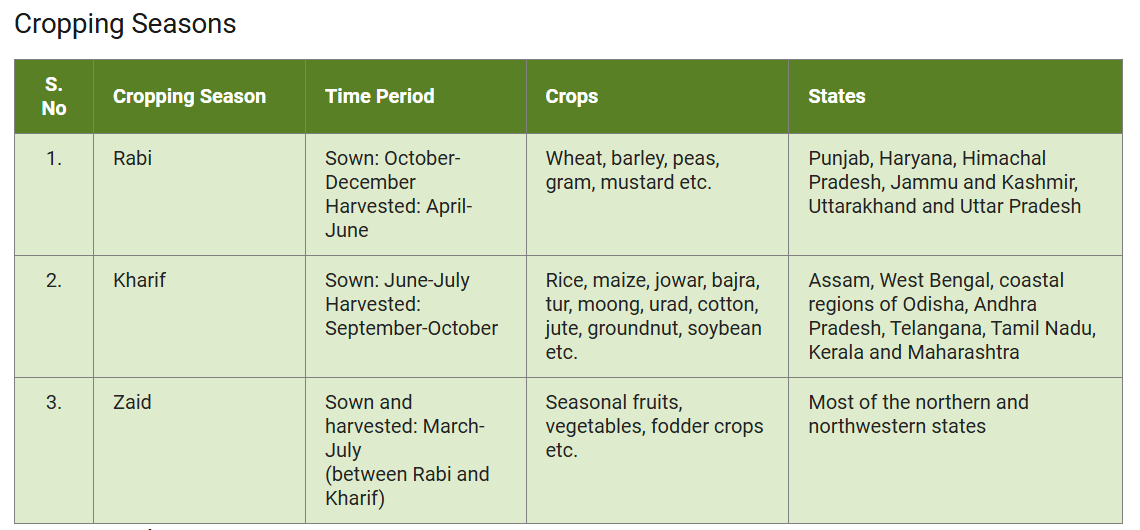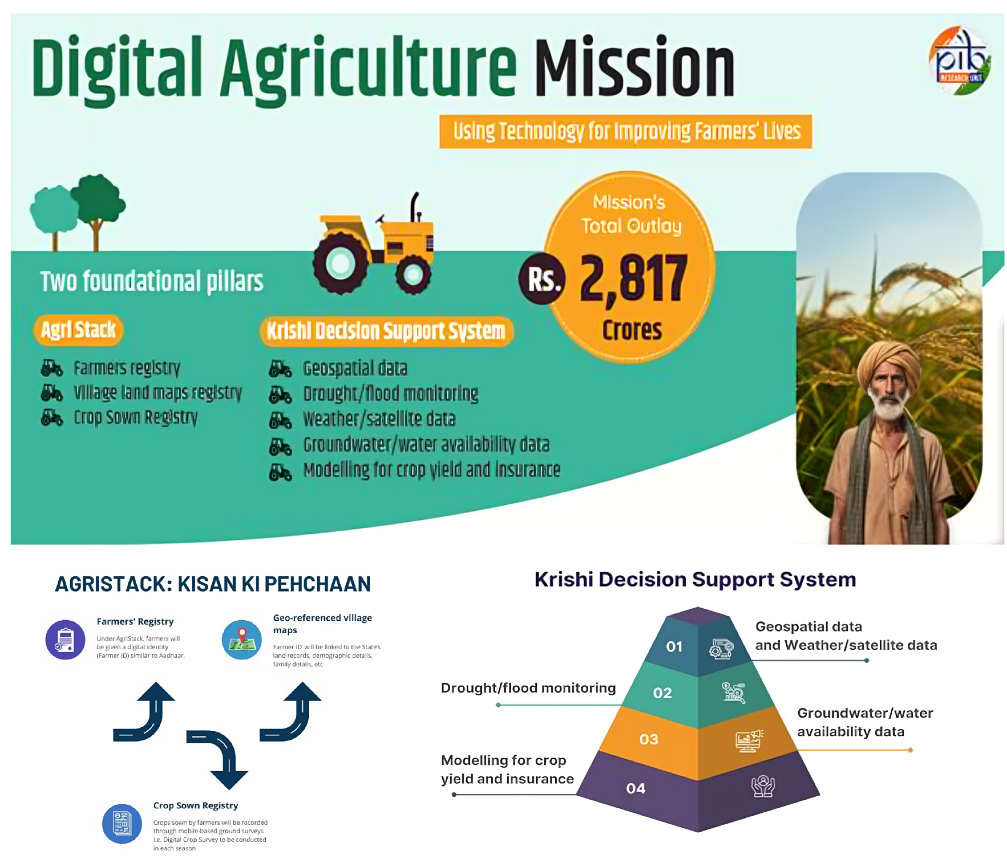Agriculture
First Advance Estimates for Kharif Crop Production
- 07 Nov 2024
- 6 min read
For Prelims: Kharif crop, Digital Crop Survey, Digital Agriculture Mission (DAM), Girdawari method, Gross Domestic Product, Digital Public Infrastructure
For Mains: India’s Food Security and E-Technology in the Aid of Farmers
Why in News?
The Ministry of Agriculture and Farmers’ Welfare has recently announced the First Advance Estimates for Kharif crop production for the year 2024-25, revealing a record-breaking output in foodgrains and oilseeds.
- The report reflects the government’s growing use of technology and stakeholder input in agricultural planning and underscores a significant rise in production, especially in staple crops such as rice and maize.
What are the Key Highlights of the First Advance Estimates for Kharif Crop Production?
- Digital Crop Survey (DCS): For the first time, the DCS under the Digital Agriculture Mission (DAM) was used to estimate crop areas, replacing the manual Girdawari method in four states (Uttar Pradesh, Madhya Pradesh, Gujarat, and Odisha).
- Record Foodgrain Production: The total Kharif food grain production for 2024-25 is projected at 1647.05 Lakh Metric Tonnes (LMT), which is higher by 89.37 LMT as compared to 2023-24 and 124.59 LMT higher than average kharif foodgrain production, due to good production of Rice, Jowar and Maize.
- Crop-Wise Estimates:
- Implications:
- Food Security: The robust production across essential crops strengthens India’s food security by ensuring a steady supply for domestic consumption and potential exports.
- Economic Impact: Higher yields can benefit the economy by supporting rural income, stabilising prices, and boosting agricultural Gross Domestic Product (GDP) contributions.
- Policy Planning: The data-backed estimates assist policymakers in designing effective support programs and supply chain strategies.
Note:
- Girdawari is a crop harvest inspection, conducted by the Patwari to assess crop yield, quality, and changes in land conditions. Held twice yearly for Rabi and Kharif crops more than twice for areas under fruits and vegetables and is called Zaid Rabi and Zaid Kharif.
- It records changes in land rights, crop conditions, soil type, and updates needed in Khasra Girdawari (village maps).
What is the Digital Agriculture Mission?
- About: The DAM is aimed at transforming the agricultural sector through digital innovation and technology-driven solutions. This mission has a budget allocation of Rs. 2,817 crore and is structured to modernise agriculture by integrating data, digital tools, and technology to make farming more efficient, transparent, and accessible.
- Components of the DAM:
- AgriStack: A comprehensive Digital Public Infrastructure (DPI) focused on farmers.
- AgriStack includes: Farmers' Registry (includes farmers’ IDs, similar to Aadhaar), and Geo-referenced Village Maps (accurate mapping of agricultural lands), and Crop Sown Registry (database recording which crops are planted and their locations).
- AgriStack aims to streamline government services, reduce paperwork, and simplify the process for farmers to access benefits.
- Pilot projects have been conducted in six states to test the creation of Farmer IDs and the DCS.
- The six states include Uttar Pradesh, Gujarat, Maharashtra, Haryana, Punjab, and Tamil Nadu.
- Key Targets Include: Creating digital identities for 11 crore farmers over three years (6 crore in FY 2024-25, 3 crore in FY 2025-26, and 2 crore in FY 2026-27)
- Launching the DCS nationwide within two years, covering 400 districts in FY 2024-25 and all districts in FY 2025-26
- Krishi Decision Support System (DSS): A geospatial system that combines remote sensing data on soil, weather, water, and crops. The system offers real-time, data-driven insights to aid farmers in making informed decisions.
- Soil Profile Mapping: High-resolution soil maps will be created for agricultural land to improve soil health understanding and support sustainable farming.
- Digital General Crop Estimation Survey (DGCES): Utilises technology to enhance the accuracy of crop yield estimates, supporting productivity and policy planning.
- AgriStack: A comprehensive Digital Public Infrastructure (DPI) focused on farmers.
- Benefits:
- Enhanced Transparency: Accurate data enables more efficient and transparent processing for crop insurance, loans, and government schemes.
- Disaster Response: Improved crop maps will help in faster response during natural disasters, aiding disaster relief and insurance claims.
- Targeted Support: With digital infrastructure, farmers can receive real-time advisories, pest management guidance, and irrigation advice tailored to their needs.
- Employment Opportunities: The mission is expected to create direct and indirect jobs in agriculture, supporting around 2,50,000 trained local youth.
|
Drishti Mains Question: Q. Analyse the economic implications of food grain production in India, particularly in terms of food security and rural income. |
UPSC Civil Services Examination, Previous Year Questions (PYQs)
Prelims
Q. Consider the following statements: (2023)
- The Government of India provides Minimum Support Price for niger (Guizotia abyssinica) seeds.
- Niger is cultivated as a Kharif crop.
- Some tribal people in India use niger seed oil for cooking.
How many of the above statements are correct?
(a) Only one
(b) Only two
(c) All three
(d) None
Ans: (c)
Mains:
Q. How is science interwoven deeply with our lives? What are the striking changes in agriculture triggered off by science-based technologies? (2020)







